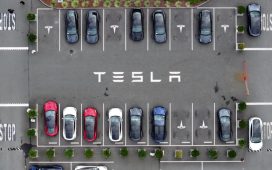Biden administration officials say they’re starting to see signs of relief for the global semiconductor supply shortage, including commitments from manufacturers to make more automotive-grade chips for car companies that have had to idle production.
U.S. Commerce Secretary Gina Raimondo, who has led President Joe Biden’s efforts on chip supply, has brokered a series of meetings between semiconductor manufacturers, their suppliers, and their customers including automakers. Senior administration officials said the meetings helped ease mistrust between the sides related to the chipmakers’ production and allocation and automakers’ orders.
The result has been more transparency about the manufacturers’ production and shipments and a gradual increase in supply for automakers, Raimondo said in an interview. The administration has also recently pressed governments in Malaysia and Vietnam to ensure semiconductor plants would be deemed “critical” businesses and maintain some production following COVID-19 outbreaks, officials said.
“You’re starting to see some improvements,” Raimondo said, adding that in recent weeks, Ford Motor Co. CEO Jim Farley and General Motors CEO Mary Barra have told her that “they’re starting to get a little bit more of what they need” and the situation is “a little bit better.”
A Goldman Sachs analysis published last month said that the peak impact of the chip shortage was in the second quarter and auto production “should jump in July.” But U.S. automakers continue to struggle with the shortage, which is estimated to be taking a $110 billion toll on the industry.
Ford is closing or curtailing production at eight factories this month, including the plant manufacturing its new version of the iconic Bronco SUV. Five of GM’s North American plants will experience “downtime” due to “semiconductor production adjustments” this month and in August, according to GM spokesman David Barnas.
And tens of thousands of new cars remain sitting in lots outside U.S. factories, waiting for the chips that power their onboard computers.
A Ford spokeswoman declined to comment. Barnas confirmed the Barra conversation with Raimondo and provided a statement the company issued July 15.
GM’s “global purchasing and supply chain, engineering and manufacturing teams continue to find creative solutions and make strides working with the supply base to maximize production of our highest-demand and capacity-constrained vehicles, including full-size trucks and SUVs for our customers,” the statement said.
The semiconductor shortage predated the Biden administration but emerged as a crisis for the new president earlier this year, when U.S. automakers were forced to begin curtailing production for lack of chips. Manufacturing of semiconductors is concentrated with a pair of Asian companies, Taiwan Semiconductor Manufacturing Co. and Samsung Electronics Co.
TSMC, a key partner to many of the world’s biggest carmakers, said last week the company will ramp up production of microcontrollers by close to 60 percent this year, a move expected to greatly boost supplies for its automobile clients starting this quarter.
Semiconductor manufacturers and auto companies generally don’t see eye-to-eye on the causes of the shortage and the solutions. Auto companies have complained about a lack of transparency in how many chips are produced and where they’re being sold, while the chips industry says the problem started when the auto industry, due to the pandemic, pulled back on orders before subsequently demanding that chips suppliers fulfill them.
Adding to Biden’s urgency to ease the strain, economists are pointing to the chip shortage as a source of inflation, which reached its highest level in 12 years in the U.S. last month, fueling Republican attacks on the president’s spending plans. A dearth of new cars that rely on the chips pushed many Americans into the secondhand car market, where the soaring prices accounted for more than one-third of last month’s increase in the cost of living.







